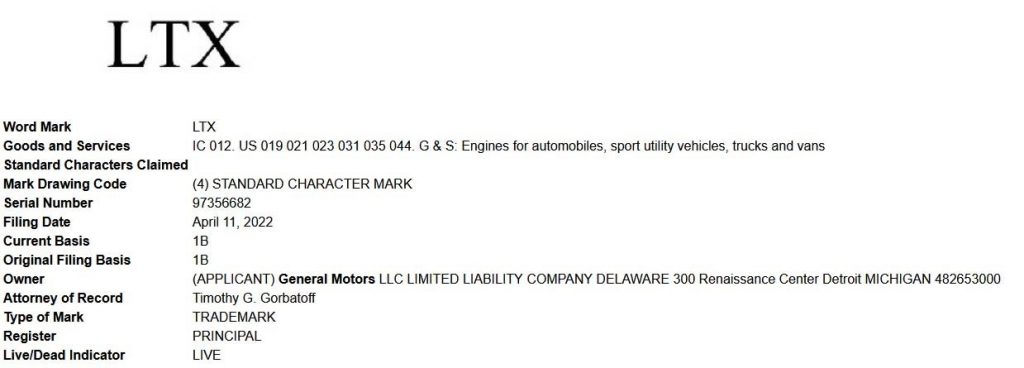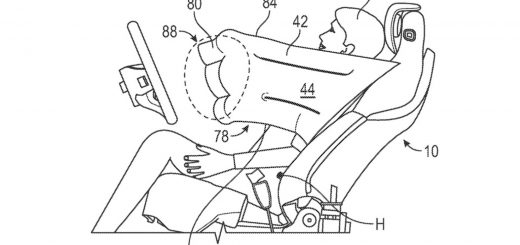GM has filed to trademark LTX for the fourth time in the last ten years for potential use on a future V8 crate engine product family, GM Authority has uncovered.
Filed on April 11th, 2022 with the United States Patent and Trademark Office (USPTO), the application is assigned serial number 97355682. The application was filed under a Goods and Services category reserved for “Engines for automobiles, sport utility vehicles, trucks and vans.” GM filed a similar LTX trademark application in 2013 in the United States and Australia, and filed it a second time with the USPTO in 2016. It also filed an LTX trademark application in Canada in 2019.
The LTX name could be used for a new V8 crate engine family from Chevrolet Performance – perhaps one that will replace the current LSX family. The LSX is a high-performance crate engine family that features a cast-iron block with additional material in certain areas, making them well-suited to high-horsepower builds. The current LSX crate engine lineup sold by Chevrolet Performance is based on the Gen IV Small Block engine family, which includes the 6.2L LS3 V8, so it seems likely the LTX engine lineup will fill a similar role, but will be more closely related to Gen V Small Block motors like the 6.2L LT1 V8.
| Mark | Filing Date | Serial Number | Patent Office | Goods & Services |
|---|---|---|---|---|
| LTX | April 11, 2022 | 97356682 | USA | Engines for automobiles, sport utility vehicles, trucks and vans |
| LTX | March 26, 2019 | 1620627 | Canada | Engines for automobiles, sport utility vehicles, trucks and vans |
| LTX | September 19, 2016 | 87175690 | USA | Engines for automobiles, sport utility vehicles, trucks and vans |
| LTX | April 10, 2013 | 1550791 | Australia | Vehicles; engines for land vehicles including engines for automobiles, sport utility vehicles, trucks and vans |
| LTX | April 2, 2013 | 85892484 | USA | Engines for automobiles, sport utility vehicles, trucks and vans |
There are many differences between the LS and LT engine families in production form. The LT engines feature improved variable valve timing, high-pressure direct injection, a different oiling system with eight injectors that spray the bottom of the pistons, repositioned intake and exhaust valves as well as larger diameter cylinder head bolts, among more. The design of the engine offers multiple improvements in production vehicles, so it will be interesting to see how these changes carry over into an LT-based performance crate engine.
GM sells the Gen 4-based LSX crate engine in two displacements, 376 cubic inches (6.16 liters) and 454 cubic inches (7.4 liters). The LS376 is rated at 476 horsepower and 444 pound-feet of torque, while the LSX454 is rated at 627 horsepower and 586 pound-feet of torque.
GM Authority will keep digging for more information on the LTX crate engine family, but in the meantime, be sure to subscribe to GM Authority for more GM trademark filing news, Chevrolet news and around-the-clock GM news coverage.


















Comments
A gen V 7.4????? 🤩 camaro please!!!!
Why would they do this? These run on that evil liquid “Gasoline”. This isn’t very green of them. What will AOC and Bernie say?
Helps that AOC and Bernie don’t know
😂 Lol ‘USA 1’ is clearly wearing his MAGA hat RIGHT NOW! Baahahahahaaaa 🤣 #MAGACLOWN 🤡
This crate engine will be much better in high temperature performance than the LSX engines for one very important reason. The LT engine has mini water jackets drilled between each cylinder, allowing for a cooler running engine in extreme temps. That is why you should not use the LSX engine if you are going to run on propane which burns hotter than hades of Pelosi’s breath. Propane burns hot because it contains about 37 percent hydrogen and is 104 octane. If GM offer a Tall Deck version like the LSX, then you can stroke it to be about 480 cubes or about 8 liters. Hey GM, use a stroker LTX with those 8 liter size and offer it in a 4500, 5500 or 6500 series truck who prefer low cost propane of CNG instead of very expensive dirty diesel. With the same LT8 bore and just change the High Deck to be able to stroke it to 4.75 inches will give 492 cubes. With a milder cam to boost lower RPM torque, it will be about 555 pounds feet of torque. Trucks don’t need to run over 4,000 RPM, so a milder cam gives max torque about 2500 to 2800 RPM. Nobody care about max HP when it’s a work truck.
So many options for increasing the HP to over 700 hp N/A. What is the cost? I have a 99 Camaro SS and it’s about time to upgrade.
USA 1…shut the …. up. Wow. Go play with your electric scooter
Just fix the engine s you have now
RE my above post, read it too. If the new LTX has basically the same internal dimensions as the LDX block, the High Deck version of the LTX will only be able to have a 4.5 inch max stroker crankshaft. this means if the bore was left the same and a stoker crank was used, it would be 16 percent larger than the existing LT8 truck engine. Since the LT8 has 464 pounds feet of torque, add the 16 percent to that and you have 538 pounds feet of torque. GM test on the old 6.0 liter truck engine showed an 8 percent increase in torque. Add the 8 percent to the 538 and you have 581 pounds feet of torque. Remember that the old 6.0 liter engine had only a 9.7 to one compression ratio. The LT8 has a CR of 10.8 to one, so with the ultra high octane of propane being 104, the increase in power because the higher CR will be closer to 10 percent increase when using propane with an LT8 engine, increase of 10 percent over 538 lbs feet will be 591 pounds feet of torque. Not too shabby.
GM wanted to Trademark their Killer Ignitions…
Then they realized the whole point was to Kill, and pretend they had nothing to do with it.